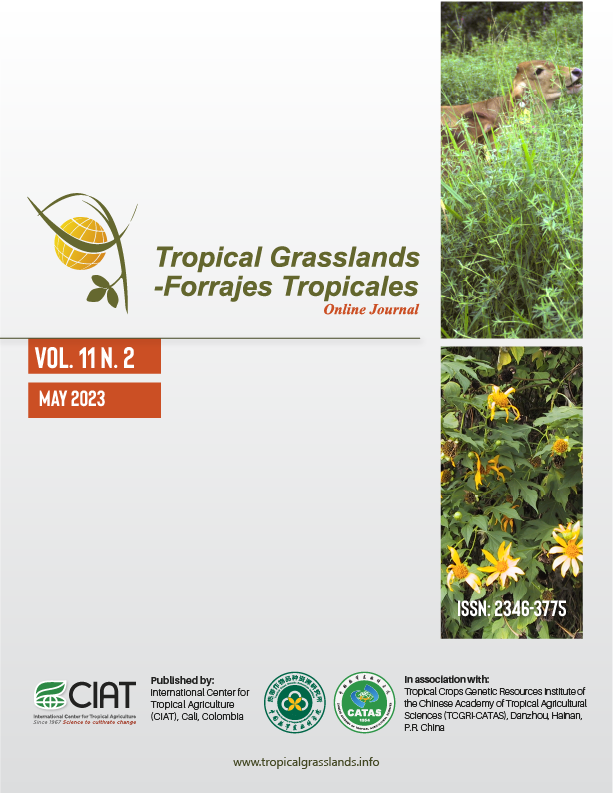Influencia de la sombra sobre la productividad y el valor nutricional de Urochloa decumbens en sistemas silvopastoriles utilizando diferentes arreglos espaciales de cultivares de eucalipto
DOI:
https://doi.org/10.17138/tgft(11)169-182Resumen
Este estudio evaluó la producción y las características nutricionales del pasto Urochloa decumbens en sistemas silvopastoriles (SSP) con diferentes variedades de eucalipto y diferentes arreglos espaciales que brindan diferentes niveles de sombra. Los SSP evaluados fueron establecidos para dar sombra más leve (eucaliptos dispuestos en hileras dobles separadas por 2 m, con árboles a cada 3 m en cada hilera y 20 m entre hileras dobles – 46 % sombreado), sombra más densa (eucaliptos dispuestos en hileras dobles separadas por 2 m, con árboles a cada 2 m en cada hilera y 9 m entre hileras dobles - 60 % sombreado) y sombra intermedia (eucaliptos dispuestos en una sola hilera, con árboles cada 2 m por hilera y 9 m entre hileras - 57 % sombreado) usando cultivares de eucalipto ‘GG100’, ‘I144’ o ‘VM58’. Además de los 3 arreglos SSP, se evaluaron dos pastizales a pleno sol, um tratado con manejo (corrección del pH del suelo y aplicación de fertilizantes como N, P y K) y otro no manejado (sin corrección ni aplicación de fertilizantes). La radiación fotosintéticamente activa (PAR) fue de 1,439 μmol/m2/s a pleno sol en comparación con una media de 715 μmol/m2/s bajo los SSP. El índice de área foliar de U. decumbens fue 28 % más alto en sombra leve que en sombra densa y más bajo en todos los tipos de sombra en comparación con los pastos manejados a pleno sol. El rendimiento de materia seca fue 58 % más bajo en 46 % de sombra y 86 % más bajo en 60 % de sombra en comparación con los pastos manejados a pleno sol. El contenido de proteína cruda en los pastos en SSP fue mayor que en pastos a pleno sol, con los valores más altos para 57 y 60 % de sombra. Los SSP redujeron significativamente la PAR y el rendimiento de forraje. Por lo tanto, en sistemas donde el objetivo principal es la producción animal, se debe utilizar un espacio entre hileras de árboles mayor a 20 m para proporcionar suficiente pasto de alta calidad.
Biografía del autor/a
Alan Figueiredo de Oliveira, Universidade Federal de Minas Gerais, Escola de Veterinária, Belo Horizonte, MG, Brazil.
Animal Science Department
Referencias bibliográficas
Alvares CA; Stape JL; Sentelhas PC; Gonçalves JLM; Sparovek G. 2013. Köppen's climate classification map for Brazil. Meteorologische Zeitschrift 22(6):711–728. doi: 10.1127/0941-2948/2013/0507
AOAC. 1995. Official methods of analysis. AOAC International, Arlington, USA.
Bjorkman O; Berry J. 1973. High-efficiency photosynthesis. Scientific American 229(4):80–93. bit.ly/45de3bt
Chatterjee N; Nair PR; Chakraborty S; Nair VD. 2018. Changes in soil carbon stocks across the Forest-Agroforest-Agriculture/Pasture continuum in various agroecological regions: a meta-analysis. Agriculture, Ecosystems and Environment 266:55–67. doi: 10.1016/j.agee.2018.07.014
Deinum B; Sulastri RD; Zeinab MHJ; Maassen A. 1996. Effects of light intensity on growth, anatomy and forage quality of two tropical grasses (Brachiaria brizantha and Panicum maximum var. trichoglume). Netherlands Journal of Agricultural Science 44(2):111–124. doi: 10.18174/njas.v44i2.551
Dias-Filho MB. 2014. Diagnóstico das Pastagens no Brasil. Documentos 402. Embrapa Amazônia Oriental, Belém, PA, Brazil. bit.ly/42MYPYS
Geremia EV; Crestani S; Mascheroni JDC; Carnevalli RA; Mourão GB; Silva SC da. 2018. Sward structure and herbage intake of Brachiaria brizantha cv. Piatã in a crop-livestock-forestry integration area. Livestock Science 212(June):83–92. doi: 10.1016/j.livsci.2018.03.020
Giro A; Pezzopane JRM; Junior WB; Pedroso AF; Lemes AP; Botta D; Romanello N; Barreto AN; Garcia AR. 2019. Behavior and body surface temperature of beef cattle in integrated crop-livestock systems with or without tree shading. Science of Total Environment 684:587–596. doi: 10.1016/j.scitotenv.2019.05.377
Gomes FJ; Pedreira BC; Santos PM; Bosi C; Pedreira CGS. 2020. Shading effects on canopy and tillering characteristics of continuously stocked palisadegrass in a silvopastoral system in the Amazon biome. Grass and Forage Science 75(3):279–290. doi: 10.1111/gfs.12478
Gómez S; Guenni O; de Guenni BL. 2012. Growth, leaf photosynthesis and canopy light use efficiency under differing irradiance and soil N supplies in the forage grass Brachiaria decumbens Stapf. Grass and Forage Science 68(3):395–407. doi: 10.1111/gfs.12002
Guenni O; Romero E; Guedez Y; Guenni LB; Pittermann J. 2018. Influence of low light intensity on growth and biomass allocation, leaf photosynthesis and canopy radiation interception and use in two forage species of Centrosema (DC). Benth. Grass and Forage Science 73(4):967–978. doi: 10.1111/gfs.12368
Lima MA; Paciullo DSC; Silva FF; Morenz MJF; Gomide CAM; Rodrigues RAR; Bretas IL; Chizzotti FHM. 2019. Evaluation of a long-established silvopastoral Brachiaria decumbens system: plant characteristics and feeding value for cattle. Crop and Pasture Science 70(9):814–825. doi: 10.1071/CP19027
Mezzalira JC; Carvalho PCF; Fonseca L; Bremm C; Cangiano C; Gonda HL; Laca EA. 2014. Behavioural mechanisms of intake rate by heifers grazing swards of contrasting structures. Applied Animal Behaviour Science 153(April):1–9. doi: 10.1016/j.applanim.2013.12.014
Müller MD; Nogueira GS; Castro CRT de; Paciullo DSC; Alves FF; Castro RVO; Fernandes EN. 2011. Economic analysis of an agrosilvipastoral system for a mountainous area in Zona da Mata Mineira, Brazil. Pesquisa Agropecuária Brasileira 46(10):1148–1153. doi: 10.1590/S0100-204X2011001000005
Oliveira AF de; Menezes GL; Gonçalves LC; Araújo VE de; Ramirez MA; Júnior RG; Jayme DG; Lana AMQL. 2022. Pasture traits and cattle performance in silvopastoral systems with Eucalyptus and Urochloa: Systematic review and meta-analysis. Livestock Science 262:104973. doi: 10.1016/j.livsci.2022.104973
Oliveira CHR; Reis GG; Reis MGF; Leite HG; Souza FC; Faria RS; Oliveira FB. 2015. Dynamics of eucalypt clones canopy and Brachiaria brizantha production in silvopastoral systems with different spatial arrangements. Agroforestry Systems 90:1077–1088. doi: 10.1007/s10457-015-9884-9
Paciullo DSC; Gomide CAM; Castro CRT; Maurício RM; Fernandes PB; Morenz MJF. 2016. Morphogenesis, biomass and nutritive value of Panicum maximum under different shade levels and fertilizer nitrogen rates. Grass and Forage Science 72(3):590–600. doi: 10.1111/gfs.12264
Paula RR; Reis GG; Reis MGF; Oliveira Neto SO; Leite HG; Melido RCN; Lopes HNS; Souza FS. 2013. Eucalypt growth in monoculture and silvopastoral systems with varied tree initial densities and spatial arrangements. Agroforestry Systems 87:1295–1307. doi: 10.1007/s10457-013-9638-5
Pezzopane JRM; Nicodemo MLF; Bosi C; Garcia AR; Lulu J. 2019. Animal thermal comfort indexes in silvopastoral systems with different tree arrangements. Journal of Thermal Biology 79:103–111. doi: 10.1016/j.jtherbio.2018.12.015
Pontes LS; Barro RS; Savian JV; Berndt A; Moletta JL; Porfirio-da-Silva V; Bayer C; Carvalho PCF. 2018. Performance and methane emissions by beef heifer grazing in temperate pastures and in integrated crop-livestock systems: the effect of shade and nitrogen fertilization. Agriculture, Ecosystems and Environment 253:90–97. doi: 10.1016/j.agee.2017.11.009
R Core Team. 2019. R: A language and environment for statistical computing. R Foundation for Statistical Computing, Vienna, Austria. R-project.org
Santos DC; Júnior RG; Vilela L; Pulrolnik K; Bufon VB; França AFS. 2016. Forage dry mass accumulation and structural characteristics of Piatã grass in silvopastoral systems in the Brazilian savannah. Agriculture, Ecosystems and Environment 233:16–24. doi: 10.1016/j.agee.2016.08.026
Santos DC; Júnior RG; Vilela L; Maciel GA; França AFS. 2018. Implementation of silvopastoral systems in Brazil with Eucalyptus urograndis and Brachiaria brizantha: Productivity of forage and an exploratory test of the animal response. Agriculture, Ecosystems and Environment 266:174–180. doi: 10.1016/j.agee.2018.07.017
Stape JL; Binkley D; Ryan MG; Fonseca S; Loos RA; Takahashi EN; Silva CR; Silva SR; Hakamada RE; Ferreira JMA; Lima AMN; Gava JL; Leite FP; Andrade HB; Alves JM; Silva GGC; Azevedo MR. 2010. The Brazil Eucalyptus Potential Productivity Project: Influence of water, nutrients and stand uniformity on wood production. Forest Ecology and Management 259(9):1684–1694. doi: 10.1016/j.foreco.2010.01.012
Tonucci RG; Nair PKR; Nair VD; Garcia R; Bernardino FS. 2011. Soil carbon storage in silvopasture and related land-use systems in the Brazilian Cerrado. Journal of Environmental Quality 40(3):833–841. doi: 10.2134/jeq2010.0162
Torres CMME; Jacovine LAG; Neto SNO; Fraisse CW; Soares CPB; Neto FC; Ferreira LR; Zanuncio JC; Lemes PG. 2017. Greenhouse gas emissions and carbon sequestration by agroforestry systems in southeastern Brazil. Scientific Reports 7:16738. doi: 10.1038/s41598-017-16821-4
Van Soest PJ. 1994. Nutritional Ecology of the Ruminant. Cornell University Press, Cornell, USA. 476 p.
Van Soest PJ; Robertson JB; Lewis BA. 1991. Methods for dietary fiber, neutral detergent fiber and nonstarch polysaccharides in relation to animal nutrition. Journal of Dairy Science 74(10):3583–3597. doi: 10.3168/jds.S0022-0302(91)78551-2
WRB (World Reference Base for Soil Resources). 2006. A Framework for International Classification, Correlation and Communication. Food and Agriculture Organization of the United Nation, Rome. bit.ly/3WleWdR
Cómo citar
Descargas
Descargas
Publicado
Número
Sección
Licencia
Derechos de autor 2023 Tropical Grasslands-Forrajes Tropicales

Esta obra está bajo una licencia internacional Creative Commons Atribución 4.0.




